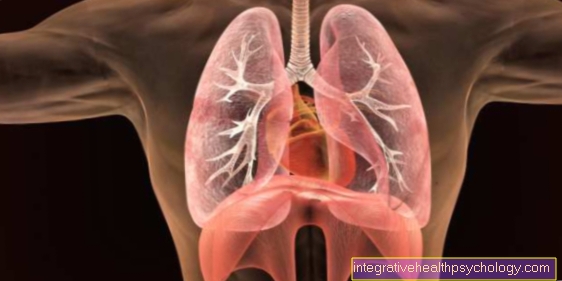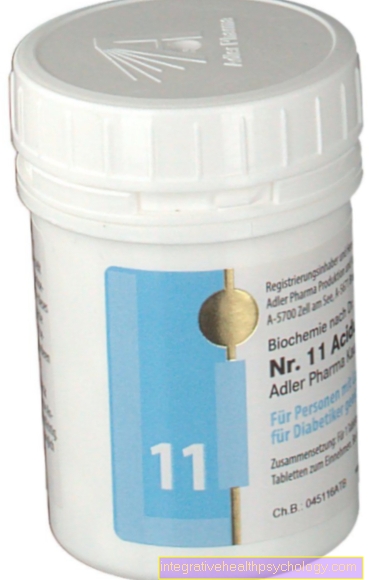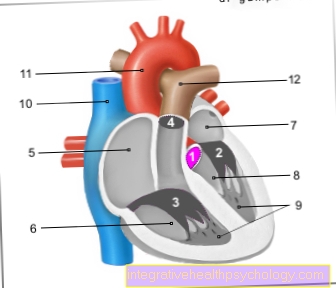Palate Cancer - Things to Watch Out For
What is palate cancer?
Palate cancer is clinically one of the tumors of the oral cavity, also known as oral cavity carcinoma.
In Germany around 10,000 people develop cancer of the oral cavity and throat every year. This means that cancer of the oral cavity and throat is the 7th most common cancer in Germany. Men are affected about twice as often as women. There are several known risk factors for developing cancers of the oral cavity and throat. The incidence peak in men is between 55 and 65 years of age, in women between 50 and 75 years of age.
Would you like to know how the palate is structured before reading the article? So first read for general information about the palate: The palate - you should know that

How do I recognize palatal cancer?
Signs of oral cavity or palate cancer are changes in the lining of the mouth. This can be hardening or discoloration of the mucous membrane as well as mucous membrane growths.
Often at the beginning of a cancer in the area of the oral cavity there is a certain precancerous stage (precancerosis) which is called leukoplakia in medical jargon. These are whitish-greyish spots or coatings in the area of the oral mucosa that cannot be wiped off.
It is important to know that the initial changes that can indicate the development of cancer are initially painless in most cases. Therefore, they are often not even noticed by those affected at first.
New, easily bleeding areas of the mucous membrane in the mouth area, swellings, a foreign body sensation in the mouth area, swallowing disorders, significantly increased bad breath and pain in the oral cavity are signs of cancer. If one of these signs occurs, the attending physician should be consulted as soon as possible.
Are you hearing the term leukoplakia for the first time and cannot associate anything with it? Leukoplakia is very important in cancer of the palate. To study the topic in detail, read also: Leukoplakia - What are the Dangers?
Accompanying symptoms in palatal cancer
In addition to the above-mentioned possible changes in the area of the oral cavity, which can be signs of cancer or a precancerous stage, there are other symptoms that can indicate the presence of palatal cancer. However, many of these symptoms are non-specific. This means that they can also occur in many other - sometimes completely harmless - diseases.
These include swelling of the lymph nodes in the area of the neck, behind the ears or above the collarbone, increased tiredness, loss of appetite, deterioration in general condition with a feeling of fatigue, weight loss, increased night sweats and pain in the head and neck area.
Pain usually only appears as a symptom in advanced stages of the disease.
Symptoms such as swallowing disorders or speech disorders are usually only present in later stages.
If one of the symptoms mentioned occurs and persists over a longer period of time, the attending physician should be consulted. He can decide on the necessary further diagnostics and, if necessary, refer you to a specialist (ear, nose and throat doctor).
The topic "B-Symptoms" contains important information on the general symptoms of cancer. To learn more about this topic and possibly compare your symptoms with these, read also: What are the B symptoms? - You should pay close attention to this!
Chances of a cure for palatal cancer
The chances of recovery from palatal cancer depend to a large extent on the stage at which the cancer is detected and treated.
While the 5-year survival rate in the early tumor stages 1 and 2 is around 70%, it is only around 43% in the advanced tumor stages 3 and 4. Looking at all stages together, the 5-year survival rate is around 50%.
Palate cancer prognosis
About every fifth person with oral cancer has a relapse, so the cancer recurs after successful treatment.
About 75% of the recurrences occur within the first two years after successful therapy. Therefore, as with any cancer, regular follow-up care plays an essential role.
During the first 2 years, check-ups should be carried out every 3 months, which include regular imaging diagnostics of the mouth and throat using computed tomography or magnetic resonance imaging.
From the 3rd to 5th year after therapy, follow-up examinations should be carried out every 6 months.
The 5-year survival rate for oral cancer is still rather poor at 50%.
Treatment of palatal cancer
The type of therapy depends on various factors: the size of the tumor, the extent of the tumor, whether lymph nodes are affected and whether the cancer has already spread (metastasis).
The general condition and age of the patient also play an important role in therapy planning.
There are two main treatment strategies for every cancer disease: curative therapy with the aim of healing the patient and palliative therapy with the aim of alleviating the symptoms as best as possible without aiming for a cure.
Palliative therapy is always used if a complete cure is no longer possible in the case of cancer or if external circumstances, for example a serious other underlying illness of the patient or a very old age, prohibit the "healing" therapy.
There are three main pillars of treatment for oral cancer: surgery, radiation therapy and chemotherapy.
These three methods are often combined with one another.
If the cancer has not yet spread, in most cases the most radical surgical removal possible is the starting point.
Surgical therapy always takes place under general anesthesia. First, the tumor tissue is surgically removed as completely as possible and with a sufficient safety margin. Depending on the area in which the tumor was located, what is known as a reconstructive intervention may then be necessary. Such a reconstruction is necessary if the original shape of the oral cavity or certain functions of the oral cavity have been impaired by the procedure.
If the oral cancer has already spread to neighboring lymph node areas, it may be necessary to remove the affected lymph node regions in the neck area. In technical jargon, one speaks of a neck dissection.
Depending on the stage of the tumor and the outcome of the operation, radiation therapy and / or chemotherapy may also be necessary after the operation.
The problem with the oral cavity is that there are many structures that need to be spared as much as possible. For this reason, radiation therapy may also be used in the oral cavity as the first choice in order to protect essential body structures. According to current studies, radiation can also be used to completely cure certain tumor stages.
Before treating palatal cancer, it is important to research the individual methods in detail. To find out about the individual treatment methods in detail, read:
- What is meant by chemotherapy?
- Treatment with radiation therapy
Irradiation of the palatal cancer
In addition to surgical therapy, radiation also plays a very important role in the treatment of oral cavity tumors.
Isolated radiation therapy can also achieve a complete cure for palatal cancer (curative therapy).
Radiation therapy can be used in isolation, but also in combination with chemotherapy or as a supplement to surgical therapy.
In radiation therapy, the tumor tissue is destroyed in the best possible way using high-energy X-rays.
Radiation therapy is used in doses so that the effects on healthy tissue are not too strong. This means that radiation therapy sessions take place several times a week, spread over several weeks.
At this point we recommend that you also look at the main page on the subject of "Radiation Therapy": Radiation Therapy - The Most Important Information
Chemotherapy for palatal cancer
Chemotherapy can also be used in the treatment of oral cancer. In most cases it is a combination of chemotherapy and radiation therapy.
In chemotherapy, a specific drug is used that is supposed to damage the cancer cells. This drug is combined with regular sessions of radiation.
In oral cancer, chemotherapy alone is only used in the context of palliative therapy, i.e. when symptoms are to be alleviated as best as possible, but a cure is no longer possible.
You can find more detailed information about the conduct and risks of chemotherapy below:
- Conducting chemotherapy
- Chemotherapy side effects
Causes of palate cancer
There are several known risk factors that favor the development of cancer in the palate or oral cavity. The two most important risk factors are chronic tobacco consumption and chronic alcohol consumption.
In the case of chronic tobacco consumption, both cigarette and cigar and pipe smoking play an important role. The chronic use of chewing tobacco also seems to have an increased risk of cancer in the oral cavity.
With a combination of both risk factors, i.e. chronic alcohol and tobacco consumption, the risk of developing oral cancer increases by a factor of 30.
The isolated consumption of tobacco products or alcohol increases the risk by about 6 times compared to the normal population.
Another known risk factor for palatal cancer is infection with certain viruses, the HPV viruses (Human Papilloma Virus 16).
There is also evidence that a very one-sided, meat-rich diet can be a risk factor for the development of oral cancer.
However, the two most important risk factors are chronic tobacco and alcohol consumption.
These factors can also lead to other diseases. For detailed information on the consequences, read:
- Illnesses related to smoking
- Consequences of alcohol
Diagnosis of palatal cancer
Cancer in the area of the oral cavity is initially noticeable due to changed areas of the mucous membrane. This can be the case in one or more places.
The unequivocal diagnosis of palatal cancer is made using a sample (biopsy). The sample is taken from the conspicuous area of the mouth; a local anesthetic is usually given beforehand with a syringe so that the sampling does not hurt. The sample taken is then examined microscopically by a pathologist.
Once the diagnosis is confirmed, further tests must be carried out to determine whether the cancer has already spread (metastasized) to other parts of the body. For this purpose, an ear, nose and throat doctor examines the throat, nose and mouth and the larynx in detail.
As a rule, a dental X-ray examination is also carried out, in which all teeth, the jaw area including the temporomandibular joints and the maxillary sinuses are shown.
A computed tomography (CT) or magnetic resonance imaging (MRI) examination of the mouth and throat should also be performed. Depending on the stage of the palatal cancer, a CT scan of the lungs may also be necessary.
Recommendation from the editor
You might also be interested in these topics:
- Tongue Cancer - Everything You Should Know
- Unwanted Weight Loss - What's Behind It?
- TNM system - the classification of cancer
- What are the symptoms of throat cancer
- What are tumor markers?





























